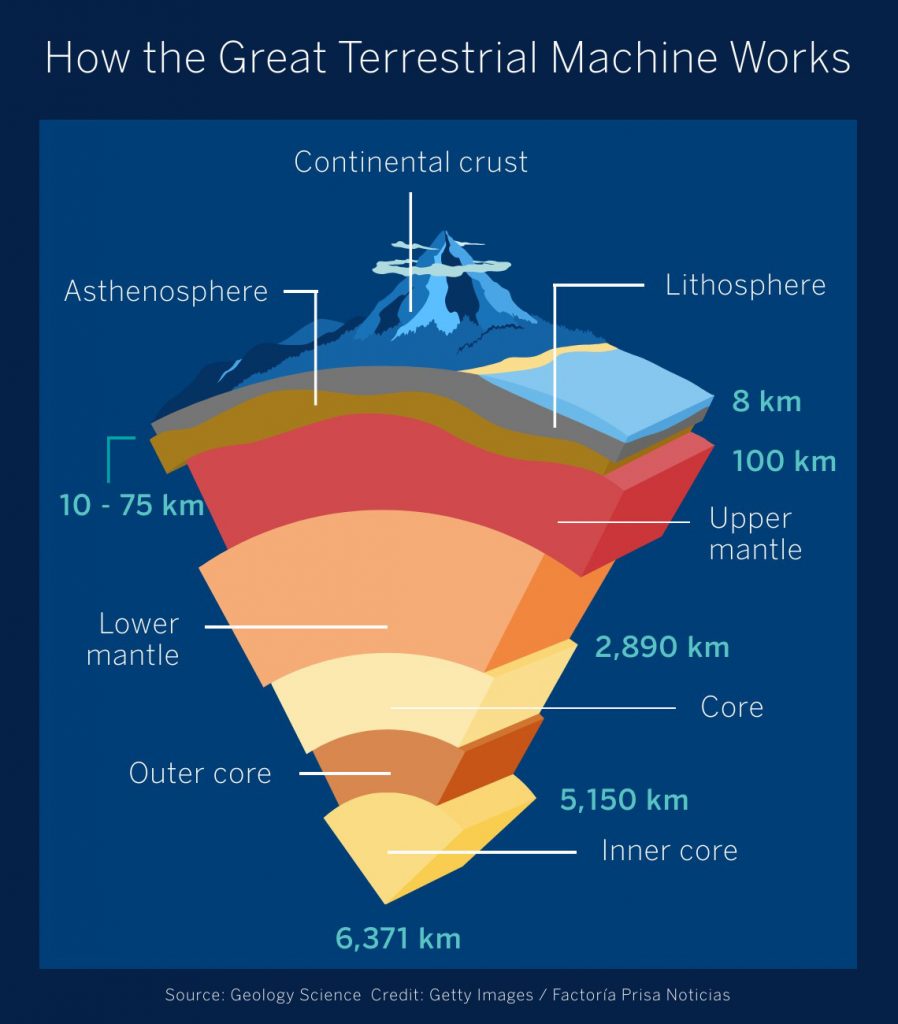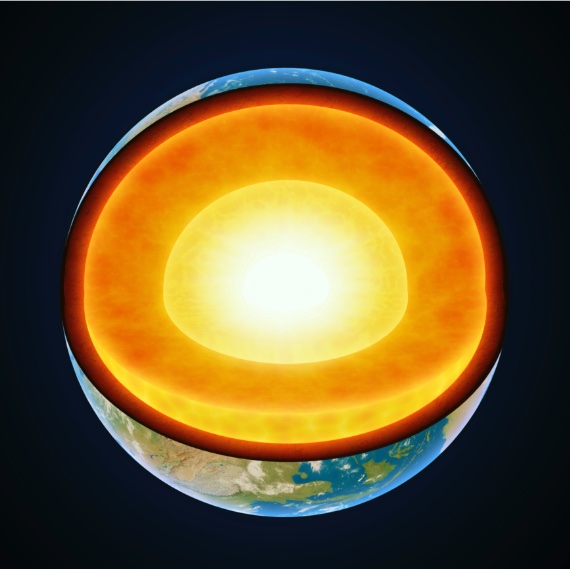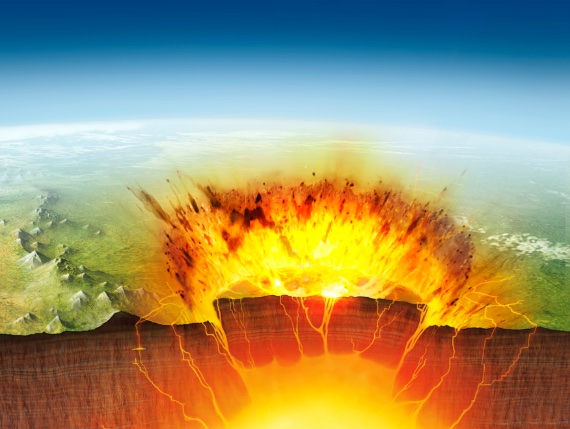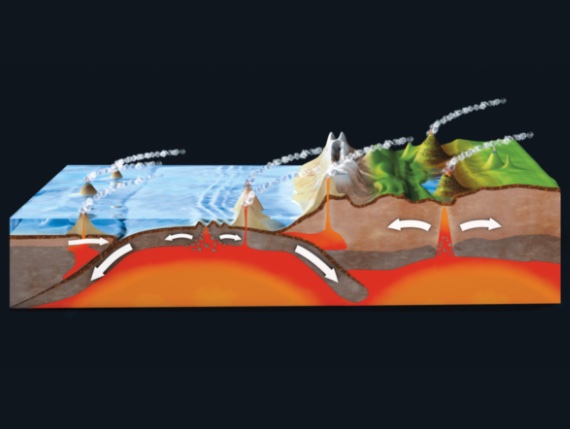Although we may only be reminded of it when the ground trembles or a volcano spits fire, our planet is not an inert lump of rock, but an enormous moving machine that has been working continuously for 4.5 billion years. And while these natural phenomena are sometimes devastating, we owe our existence to the functioning of this great machine. Scientists do not subscribe to the idea that the emergence of humans was inevitable; on the contrary, they tend to think that we are the product of an improbable lottery of factors, of which we have yet to find another example. And this functioning can be disrupted by tinkering with its parts, as is the case with anthropogenic climate change. Let’s take a look at the workings of this terrestrial machine we call home.

Inner core
One of the most astonishing human achievements is that a species that inhabits the surface of the Earth and that using the mechanical means at its disposal has only been able to drill into the ground to a depth of little more than 12 kilometres—just 0.2% of the distance to the Earth’s core—has nevertheless been able to use science to figure out what lies at the centre of the planet, 6,378 kilometres below our feet.

At the deepest heart of the planet lies the solid inner core, a sphere with a radius of about 1,220 km, or one-fifth of the Earth’s total radius. We owe our knowledge of it to the Danish seismologist and geophysicist Inge Lehmann, who deduced its existence in 1936 by studying the behaviour of seismic waves. It is thought to be composed mainly of an alloy of iron and nickel, which despite the high temperature—more than 5,400 °C at its surface—is kept solid by the enormous pressure of 3.3 million atmospheres. Two decades ago, it was suggested that the inner core might actually have more than one layer, and this was supported by subsequent research. In 2023, a new study deduced the existence of an innermost inner core, a dense metallic ball of iron with a radius of about 650 km.
This small inner sun, created from the heat left over from the formation of the Earth and contributed to by the decay of radioactive isotopes, is key to keeping the planet warm—unlike Mars, whose interior cooled more rapidly due to its smaller size. But despite its high iron content, and although its presence influences the magnetic field, the inner core is not itself a magnet, because above a temperature threshold—770 °C in the case of iron—permanent magnetism is lost. It is the outer core that is responsible for the magnetic field that supports life on our planet.
Outer core
In the outermost region of the core, where pressures are somewhat lower, high temperatures melt the core’s metal. This was a key factor in separating the fates of Earth and Mars, planets that began their existence in similar conditions. But the smaller size of the latter caused its interior to cool; its inner core is thought to be liquid, while the outer core solidified, eliminating the magnetic field and allowing the solar wind to gradually strip away its atmosphere, turning it into the desert planet it is today.
This illustrates the importance of the Earth’s liquid outer core, whose circulation produces a dynamo effect that generates a magnetic field that shields us from cosmic radiation and the solar wind. This layer, which is about 2,260 km thick and ranges in temperature from 2,700 °C to 7,700 °C, is composed of iron and nickel, as well as other lighter elements such as sulphur, silicon, carbon, oxygen and hydrogen.

The liquid outer core allows the inner core to rotate at a different speed than the rest of the Earth, somewhat faster or slower. In 2023, a study suggested that in 2009 the core began to slow down its super-rotation (faster than the Earth’s surface) and may now be lagging a little behind, something that would happen in cycles of about 70 years. Not all scientists support these conclusions, but in any case, it is something that has no bearing on life on Earth.
This reminds us that the Earth is a moving machine that subject to change. Due to fluctuations in magnetism, the north and south magnetic poles shift over time. This movement has accelerated recently, from about 15 km per year until the 1990s to about 55 km today. Over the past 71 million years, the poles have reversed 171 times. During these transitions, the magnetic field shrinks, something that has been happening for the last 3,000 years. If we are heading for a magnetic pole reversal, as some scientists believe, this could leave terrestrial life unprotected from solar and cosmic radiation in just a few hundred years. Moreover, as the Earth cools, part of the molten outer core is solidifying, so that the inner core is growing at a rate of about 1 millimetre per year—a reminder that one day, far in the future, the Earth will no longer be habitable.
Mantle
Above the core is the mantle, a solid layer that accounts for most of the Earth’s mass (67%) and volume (84%). Its 2,900 km thickness is mostly composed of silicates. The mantle has three distinguishable layers: the lower mantle (near the outer core), a transition zone and the upper mantle. These layers are differentiated by their composition, but mechanical properties such as fluidity and elasticity give rise to further subdivisions: the asthenosphere, a region of the upper mantle that is solid but ductile, and the more rigid lithosphere, which comprises the outermost edge of the mantle and the Earth’s crust.

The viscosity of the asthenosphere allows convection currents to form, bringing magma to the surface and supporting the tectonic plates. For all these reasons, the mantle is the engine that drives the great geological phenomena: plate tectonics, mountain formation, volcanoes and earthquakes.
Crust
The Earth’s crust, the only layer to which we have direct access, is a thin, light, rocky skin that covers the planet, accounting for only 1% of its total volume and mass and ranging in thickness from a minimum of 5 km in the oceanic crust to 70 km in the thicker continental crust. The crust is where all the effects of the movement of the Earth’s machinery are manifested. Plate tectonics plays a key role in this.

The lithosphere—the crust and upper edge of the mantle—is divided into seven major tectonic plates, with an average thickness of 125 km, plus smaller plates and microplates. The Earth’s crust is created at mid-ocean ridges and destroyed at subduction zones. For 3.4 billion years, tectonic plates have been moving and changing the face of the planet, joining and breaking apart continents, as first proposed by Alfred Wegener in 1912.
But while this terrestrial dynamic threatens us with earthquakes and volcanic eruptions, it has also allowed life to flourish: plate tectonics, along with erosion and other atmospheric processes, maintains a cycle of carbonates and silicates that acts as a key regulator of the climate that makes life possible (and which we are altering by extracting and burning fossil fuels). This has implications for the possibility of life on other planets; although evidence of possible tectonic activity has been found on other worlds in the Solar System, notably Europa (a moon of Jupiter), this phenomenon may be rare on extrasolar planets, which could reduce the chances of life developing.
Javier Yanes
Comments on this publication